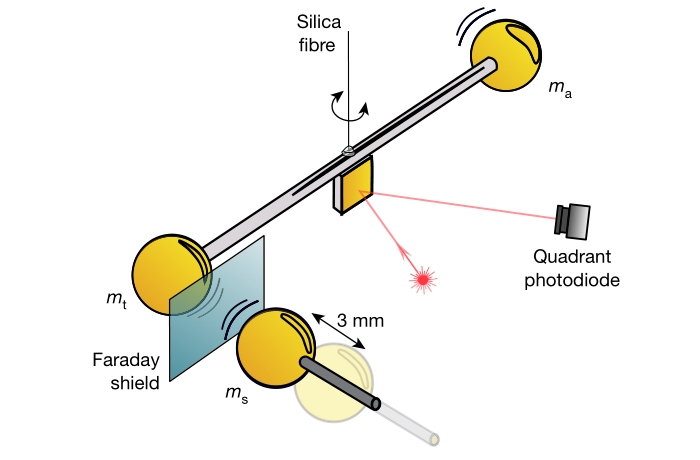
The tiny force field between two 90-milligram spheres of gold has just been measured for the primary time.
This makes it officially the littlest field ever successfully measured - an achievement that might open the door to probing gravitational interactions within the quantum realm.
There's a big problem with the mathematics we use to explain the Universe; specifically, the way gravity behaves. Unlike the opposite three fundamental forces within the Universe - weak, strong and electromagnetic - gravity cannot be described with the quality model of physics.
Einstein's theory of Einstein's theory of relativity is that the model we use to explain and predict gravitational interactions, and it works beautifully in most contexts. However, once we get right down to quantum scales, general relativity theory breaks down, and quantum physics takes over. Reconciling the 2 models has to this point proven very difficult.
General relativity supersedes an earlier model, Newton's law of universal gravitation, which hadn't incorporated the curvature of spacetime. It states that gravity between two objects is directly proportional to the merchandise of their masses and inversely proportional to the square of the gap between their centers.
Newtonian physics works well for many terrestrial applications, whether or not it stumbles a touch in an astrophysical setting.
But what about really, really small gravitational interactions? Typically, these are really challenging to live, because it is so difficult to uncouple them from the consequences of Earth's gravity and other perturbations. Most tests of gravity on smaller scales have involved masses of a minimum of a kilogram (2.2 pounds).
Now, we've gone considerably smaller. to attain this, a team of scientists led by Tobias Westphal of the Austrian Academy of Sciences in Austria actually turned to the 18th century for inspiration: Namely, the very first experiment to live gravity between two masses, and provides the primary accurate values for the constant.
This was designed by a physicist, an English scientist who discovered a way to effectively nullify Earth's gravity. He created a measuring instrument, attaching lead weights at each end of a horizontally suspended rod.
The attraction between the weights caused the rod to rotate, twisting the wire on which the rod was suspended, allowing Cavendish to live the gravity supported what quantity the wire twisted. The set-up came to be referred to as the Cavendish experiment.
Westphal and colleagues modified the Cavendish Experiment for his or her tests of gravity on a tiny low scale. Their masses were tiny gold spheres, each just 1 millimeter in radius and 92 milligrams in weight.
On these scales, the team needed to account for a variety of sources of perturbations. Two gold spheres were attached to a horizontal glass rod at a separation of 40 millimeters. one among the spheres was the test mass, the opposite the counterbalance; a 3rd sphere, the source mass, was moved near the test mass to make a fundamental interaction.
A Faraday shield was wont to block the spheres from interacting electromagnetically, and therefore the experiment was conducted in a very chamber to stop acoustic and seismic interference.
 (Westphal et al., Nature, 2021)
(Westphal et al., Nature, 2021)
A laser was bounced off a mirror within the center of the rod to a detector. because the rod twisted, the movement of the laser on the detector indicated what proportion attraction was being exerted - and moving the source mass allowed the team to exactly map the field of force generated by the 2 masses.
The researchers found that, even at these small scales, Newton's universal law of gravitation still holds firm. From their measurements, they were even able to calculate the gravitational, or Newton's, constant (G), deriving a worth just 9 percent from the internationally recommended value. This discrepancy can, they said, be entirely covered by the uncertainties in their experiment, which wasn't designed to live G.
In all, their result shows that even smaller measurements are also undertaken within the future. this might help scientists to probe the quantum regime, and potentially offer insights into substance, dark energy, string theory, and scalar fields.
"Our experiment provides a viable path to enter and explore a regime of gravitational physics that involves precision tests of gravity with isolated microscopic source masses at or below the Planck mass," they wrote in their paper.
"This reveals possibilities like a unique approach to see Newton's constant, which thus far remains the smallest amount well determined of the basic constants. In general, miniaturized precision experiments may allow tests of the inverse-square law of gravity at considerably smaller scales than possible today."
The research has been published in Nature.
 Reviewed by Admin
on
March 12, 2021
Rating:
Reviewed by Admin
on
March 12, 2021
Rating:



No comments: